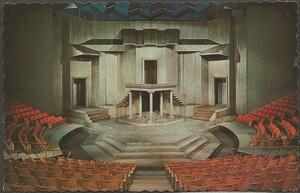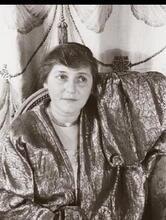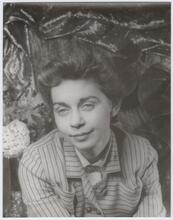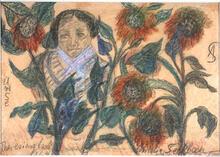Tanya Moiseiwitsch
Regarded as one of the foremost designers in twentieth-century theater, Tanya Moiseiwitsch was an innovative designer of costumes, sets, and stages, responsible for over two hundred productions in England, Canada, and the United States. She made an impact in the male-dominated world of stage design. Moiseiwitsch’s professional debut in 1934 was as production designer for John Masefield's The Faithful at the Westminster Theatre. Moiseiwitsch conceived a wood stage to establish the Shakespeare Festival Theatre in Stratford, Ontario. Over the years, she designed over forty productions at Stratford. In tribute to her outstanding influence in the development of twentieth-century stage design she was awarded two honorary doctorates, from the University of Toronto in 1988 and the University of Minnesota in 1994, and a CBE in 1976.
Regarded as one of the foremost designers in twentieth-century theater, Tanya Moiseiwitsch was an innovative designer of costumes, sets, and stages, responsible for the look of over two hundred productions in England, Canada, and the United States, and one of the few women to make an impact in the overwhelmingly male-dominated world of stage design.
Early Life and Family
Moiseiwitsch was born in London on December 3, 1914 to musicians Benno Moiseiwitsch (1890–1963) and Daisy Kennedy (1893–1981). Benno, born in Odessa, came to London at the age of eighteen, already a noted and prize-winning pianist, having studied first in Odessa and then in Vienna. It was in Vienna that he met the Australian-born violinist Daisy Kennedy, who came to London with him and whom he later married. They had two daughters, Tanya and Sandra (1922–1996). Benno and Daisy divorced in 1924; both remarried, Daisy to the poet John Drinkwater, with whom she had a daughter, Penny (b. 1928), and Benno to Anita, with whom he had a son, Boris. Although her mother was not Jewish, Tanya grew up with a strong sense of Jewish identity and always considered herself Jewish. Tanya was a talented pianist and her parents encouraged her to further her musical studies, but she chose to pursue a career in the visual arts, training first at the Central School of Arts and Crafts in London and then as an apprentice scene painter at the Old Vic.
Design Career
Moiseiwitsch’s professional debut in 1934 was as production designer for John Masefield's The Faithful at the Westminster Theatre. Soon afterwards she was invited to join the Abbey Theatre in Dublin, where she stayed for five years. She was instrumental in modernizing the highly reputed but old-fashioned theater, which had been languishing in a moribund Yeatsian naturalistic theatrical language. In 1939 she returned to England and went to work at the Oxford Playhouse. It was there that she met and fell in love with Felix Krish, an assistant stage manager, whom she married in 1944. They had been married only a few weeks before he was called up to join the Royal Air Force. A few weeks later he was killed on a flight training exercise. Moiseiwitsch, who never remarried, kept a photograph of Felix and his letters by her bed until she died.
In 1945 Moiseiwitsch embarked on her first collaboration with Tyrone Guthrie at London’s Old Vic, designing the set and costumes for Cyrano de Bergerac, starring Ralph Richardson. She designed the set for Guthrie’s 1947 production of Peter Grimes at Covent Garden and began working at the Festival Theatre in Stratford on Avon, where she designed a permanent set for a series of Shakespeare’s history plays mounted for the Festival of Britain, with Richard Burton playing Henry V and Michael Redgrave Richard II. Already Moiseiwitsch was developing a clear, suggestive and flexible language for her stage design. She built the stage in unvarnished oak and on different levels, with a throne draped in different fabrics to convey different layers of meaning in the different contexts of each of Shakespeare’s disquisitions on kingship.
When Guthrie was invited to Canada to establish the Shakespeare Festival Theatre in Stratford, Ontario, he asked Moiseiwitsch to join him. The stage conceived by Guthrie and Moiseiwitsch was again of wood, thrusting out into the audience and fostering a sense of intimacy between actors and audience. It had five sides and was stepped, with entrances on all sides. Over the years she designed more than forty productions at Stratford.
Guthrie and Moiseiwitsch collaborated on several Shakespeare plays, mostly set in the twentieth century. However, their most celebrated production was Oedipus Rex in 1954, with James Mason. The production drew on the ritualistic essence of Greek theater, with the actors in huge, abstract masks, Oedipus like a great sun. According to novelist Robertson Davies, the mask of Tiresias the blind prophet “suggested the bony head of a bird, ivory-white, beaked and sightless.” In 1957 the production became a film.
Because Moiseiwitsch usually designed both set and costumes for a production, there was a strong sense of visual unity in her productions. Her sets became more pared down as the century progressed, creating a theatrical space in which her costumes became expressive emblems, sculpted by dramatic and suggestive lighting. Moiseiwitsch’s highly conceptual, abstract notion of theater design, using visual elements to elaborate on the metaphorical significance of the play, has been extremely influential in contemporary theater design all over the world.
In Minneapolis, where she was the principal designer at the Guthrie Theater from 1963–1966, she again designed a thrusting stage similar to that she had designed (and in 1962 modified) in Stratford. Her many productions in Minneapolis include The House of Atreus in 1968, another highly regarded masked production, whilst at the Metropolitan Opera in New York she designed Peter Grimes (1967) and later Rigoletto (1977) and La Traviata (1981).
Legacy
Returning to England in the 1970s, she designed plays both for the National Theatre and the West End, as well designing the stage for the Crucible Theatre, Sheffield. She won awards for the 1973 production of Molière’s The Misanthrope, directed by John Dexter, with whom she had worked at the Metropolitan Opera, and starring Alec McCowen and Diana Rigg; in 1975 for Racine’s Phaedra Britannica, again with Dexter, McCowen and Rigg, and for Congreve’s The Double Dealer in 1978.
In tribute to her outstanding influence in the development of twentieth-century stage design she was awarded two honorary doctorates, from the University of Toronto in 1988 and the University of Minnesota in 1994, and a CBE in 1976. A short time before she died on February 19, 2003, she was awarded the Order of Canada.
Blom, Patricia VandenBerg. "Tanya Moiseiwitsch, Costume Designer: the Creative Process." (1983): 0307-0307.
Hofler, Robert. "Obituaries: Tanya Moiseiwitsch." Variety 390, no. 3 (2003): 79-79.
Thorne, Gary. Stage design: A practical guide. Crowood, 2011.
Tanya Moiseiwitsch collection (PA080), Performing Arts Archives, University of Minnesota Libraries, Minneapolis, Minnesota.
Moiseiwitsch, Tanya. "Stage Design Throughout the World Since 1950 (Edited by René Hainaux and Yves-Bonnat)(Book Review)." Theatre Journal 17, no. 2 (1965): 146.
Moiseiwitsch, Tanya, Suzy Benzinger, Drew Scott Harris, Sue Woodman, and Ruth Moore. Tanya Moiseiwitsch. 2008.










